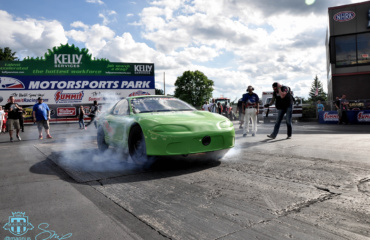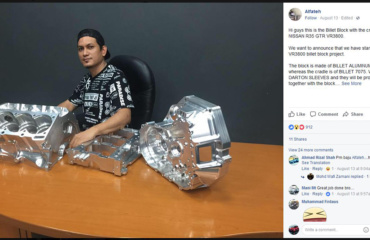1G in a 2G

How to put a 1G engine in a 2G car. Complete installation guide.
So here it is finally an easier way for you 2G owners to get away from the dreaded crankwalk.
It seems this was the answer most of you wanted, so we found a solution on how to mate the 1G motor utilizing the 1G cam and crank sensor trigger assembly to the stock 2G computer.
Using this fix will also alleviate the weak timing that has always plagued the 2G’s (4-6 degrees retarded on the 95-96, 97-up is very timing sensitive to airflow based on turbo size, but base idle timing can be adjusted)
There have been some questions regarding being able to use the tensioner tool. Because we are mating a 1G tensioner arm to a 2G engine mount, the holes for the tensioner tool no longer line up, the tensioner must now be compressed manually.
You can see where the 2G mount must be trimmed to clear the 1G water pump, the only cutting involved.
Here is the heart of the whole mod and what makes it all possible, a 1G cam sensor, mounted in the original location. Pictured here is a JDM Galant sensor, we like it because the wires can reach all the way to the engines drivers side, and no need to go hunting for a connector. Plus we have about 20 sitting on the shelf, same as a 1989-90 unit apparently.
Parts List
- 1G CAS (91-92 Optical Effect, 93-94 Hall Effect)
- 1G Oil Cooler (90-92 MD 157670 6bolt water cooled oil cooler)
- 1G Water Pump
- 1G Oil Pump/Front Case
- 1G Timing Belt necessities
- 2G Engine mount (modified) use 2G engine mount trimmed, with 1G tensioner arm
- 1G Timing Belt Covers (modified)
- 1G 90-92 6-bolt block (with whatever internals)
- 1G 6-bolt Flywheel
- 2G Starter Mounting bracket
- 1G Water Pipe
- 1G lower radiator hose
- 1G Thermostat housing/ Water Neck
- 1G 6-bolt oil pan Balance shafts (remove them or keep em, its up to you, we take them out) 2G Alternator
- 2G Power Steering Pump
- 2G A/C 2G Belts
Additional Notes
On a 95-96 car with stock 2G head
- Swap Plugs 1 and 4 with 2 and 3 (order is not important)
On a 97+ car with stock 2G head
- No plug swap or injector swap is necessary
For a complete 1G 6-bolt head/block
- Swap 2G ISC with 1G Throttle body 1G Coil pack and bracket
- 1G Head with internals
- 1G Intake manifold with stock 2G knock sensor
- Reuse 2G sensor including oil, water temp, etc.
- 2G fuel rail to accommodate 2G Fuel Pressure Regulator
- 2G MAP sensor either in Intake Mani or T-d off of Brake booster Vac line
- Relocate power transistor mount
- Special thanks to the whole DSM1Gina2G list members who have helped in providing the useful information needed to compile this detailed list, Sean Caron for providing the car and motivating me. Justin and Robert from the RRE crew who fought hard when they were cutting oil pump covers, no more; just bolt it in with hand tools.
Installing a 1G Cam Angle Sensor in a 2G
Anatomy of a Cam Angle Sensor
There are three types of cam angle sensor that are known to work. The early years (89-92) have a metal green/gray cover, use a flat rotating disk with slots, and an optical sensor. The later year sensor (93-94) has a black plastic cover, uses curved metal plates that rotate through a hall-effect sensor. The hall effect sensor is physically similar to the technology used in the 95-96 cam and crank sensors. Theoretically the hall effect sensor is higher resolution. They all work.
89-90
MD121786
Green Lid, Optical Type, Long Wire Harness 91-92
MD148855
Green Lid, Optical Type, Plug Harness 93-94
MD184529
Black lid, Hall Effect Type, Plug Harness
Wiring Instructions
- Make a wiring harness.
Due to the inverted Cam signal, injector trigger wires will need to be switch on 95-96 year ECU cars with this wiring diagram in order to bring the signals back into phase. The difference is subtle, but the motor will start easier, provide smoother idle, and have less hesitations during mild acceleration.
Use the following diagram:
When removing the pins on your ECU wiring harness be patient and delicate. It requires no force to remove the pins. Consult the diagram in the front of your electrical service manual regarding the proper way to inspect and remove pins. You will need a tiny jewelers screwdriver, (1/16 in) to release a plastic catch holding the pin’s in. Use a flashlight and take a good look at the harness before beginning.
Green: Pin 1 is now 14
Green w/ yellow stripe: Pin 2, is now Pin 1
Green w/ red stripe: Pin 15, is now Pin 2
Yellow w/ black stripe: Pin 14 is now Pin 15
Refer to the final page of this document for all ECU pin allocations
The spark coil signal is inverted. Looking at the coils, label each wire A,B,C,D. Change the spark plug wire locations: A is now C, B is now D, C is now A and D is now B. Another way to do this is to change the trigger wires to the coil, (3 wire triangle plug, next to the igniter). Switch the two blue wires. One is blue with red stripe, the other is blue with black stripe. The third wire that remains unchanged is black with white stripe.
- Bend or remove any brackets that would get in the way of the installed 1G CAS
- If you have a 2G head, remove your 97-99 CAS, or remove the rubber coated metal cap from the left end of the intake cam on your 95-96
- Rotate the motor to Top Dead Center (TDC) #1 cylinder. The cam alignment pins will be at 12:00. The timing marks will be lined up at 3:00 on the exhaust cam and 9:00 on the intake cam. Those two marks will be lined up directly through the centerline of the cam bolts in the center of the pulleys.
- Align the marks on the 1G CAS to TDC and Install. Set the CAS at its mid-range of adjustment.
Lined up 180 degrees out
Lined up correct for TDC #1
- Make sure the ignition key is off and the ECU fuse is pulled. At this time make changes to your plug wires and injector wires if necessary. Connect your custom wiring harness to the 1G CAS. Route the harness away from extreme heat possible noise generators, (spark plugs, coil’s, alternators etc.) Behind/under the intake manifold works fine.
- Replace the ECU fuse and start the car.
Setting the base timing
- Connect a timing light to battery power (+ and -) and the Number 1 spark plug.
- Connect a data logger to the car and display timing advance and RPM
- Allow the car to come up to temp. Coolant 212 deg F, 750 RPM +/- 100, Fan’s should cycle on and off
- Read the timing from the crank with no load on the motor. Each mark is 5 deg no fans, no lights, no A/C etc.
- Adjust the position of the CAS until the readings from the TIMING LIGHT, match the timing advance displayed on the data logger. This is “stock” advance. If you have a mild setup with stock cam’s you’ll pass the smog inspection if your ECU timing and crank timing reads 5 deg +/-3 deg BTDC at idle
- Add additional timing at own risk, (Timing light advance) – (ECU advance) = (Base Timing Shift) see: “The bad”
- Tighten the 12mm nuts/bolts that hold the 1G CAS
Troubleshooting
IF CHECK ENGINE LIGHTS OCCUR! TRY THIS:
Many people using the 1G CAS on a 2G head have been running into problems with misfire engine codes while at cruise. Many different things have been blamed for this and many different fixes have been attempted.
This fix will keep the ECU from looking for misfires at all. This is the criterion that must be met before the ECU will start to look for misfires:
- 300+ seconds of steady state RPM less than 80% throttle position
- Engine coolant temperature -10C or higher
- Intake air temperature -10C or higher
- Barometric pressure greater than 76 kPa
Now if we can get one of these values outside of the criteria the ECU won’t check for misfires. The value that would be the easiest to change would be the barometric pressure sensor. We’re going to add resistance to this value so that the ECU will see less barometric pressure than what there really is. This will also lean the car out so you should see a performance increase as well. Depending on the car and altitude you might need to add more fuel with an AFC.
So let’s get started, Parts needed:
- A 10K potentiometer (although a 5K would probably do just fine). These are available at any electronics store, if you go to Radio Shack ask for a volume control knob because they don’t know what a potentiometer is.
- Wire strippers
- Soldering iron
Step 1: Remove the access panel on the driver’s side of the center console. You should now see four plugs with a ton of wires going to them.
Step 2: Pull out the top plug, it’ll be the one that’s the hardest to reach. Locate wire #85. It’s orange with a white stripe.
Step 3: Cut the orange wire in half. Solder one end of the wire to the center peg of your potentiometer. Solder the other end to either the left or right leg, it doesn’t matter which. Turn your potentiometer all the way counter-clockwise.
Step 4: Plug the harness back in and start up the car. It should sound like it did before you did any modifications. If the idle is choppy or the car won’t run you turned your potentiometer the wrong way.
Step 5: Add resistance to the barometric pressure sensor by slowly turning the knob on the potentiometer. Drive the car around; if you get a CEL then add some more resistance. Keep doing this until you no longer get the CELs.
















